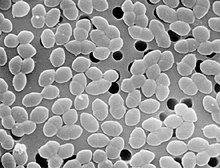Diplococcus
It has been suggested that this article be merged into Bacterial cellular morphologies. (Discuss) Proposed since December 2023. |

A diplococcus (plural diplococci) is a round bacterium (a coccus) that typically occurs in the form of two joined cells.
Types[edit]
Examples of gram-negative diplococci are Neisseria spp. and Moraxella catarrhalis. Examples of gram-positive diplococci are Streptococcus pneumoniae and Enterococcus spp.[1][2] Presumably, diplococcus has been implicated in encephalitis lethargica.[3]
Taxonomy[edit]
Gram-negative diplococci[edit]


Neisseria spp.[edit]
Phylum: Proteobacteria
Class: Betaproteobacteria
Order: Neisseriales
Family: Neisseriaceae
Genus: Neisseria
The genus Neisseria belongs to the family Neisseriaceae. This genus, Neisseria, is divided into more than ten different species, but most of them are gram negative and coccoid. The gram-negative, coccoid species include: Neisseria cinerea, Neisseria gonorrhoeae, Neisseria polysaccharea, Neisseria lactamica, Neisseria meningitidis, Neisseria mucosa, Neisseria oralis and Neisseria subflava. Of these Neisseria species, the most common, pathogenic species are N. meningitidis and N.gonorrhoeae.[4]
Moraxella catarrhalis[edit]

Phylum: Proteobacteria
Class: Gammaproteobacteria
Order: Pseudomonadales
Family: Moraxellaceae
Genus: Moraxella
The genus Moraxella belongs to the family Moraxellaceae. This genus, Moraxellaceae, comprises gram-negative coccobacilli bacteria: Moraxella lacunata, Moraxella atlantae, Moraxella boevrei, Moraxella bovis, Moraxella canis, Moraxella caprae, Moraxella caviae, Moraxella cuniculi, Moraxella equi, Moraxella lincolnii, Moraxella nonliquefaciens, Moraxella osloensis, Moraxella ovis and Moraxella saccharolytica, Moraxella pluranimalium.[5] However, only one has a morphology of diplococcus, Moraxella catarrhalis. M. catarrhalis is a salient pathogen contributing to infections in the human body.[6]
Gram-positive diplococci[edit]
Streptococcus pneumoniae[edit]

Phylum: Firmicutes
Class: Bacilli
Order: Lactobacillales
Family: Streptococcaceae
Genus: Streptococcus
Species: Streptococcus pneumoniae
The species Streptococcus pneumoniae belongs to the genus Streptococcus and the family Streptococcaceae. The genus Streptococcus has around 129 species and 23 subspecies[7] that benefit many microbiomes on the human body. There are many species that show non-pathogenic characteristics; however, there are some, like S. pneumoniae, that exhibit pathogenic characteristics in the human body.[8][2]
Enterococcus spp.[edit]

Phylum: Firmicutes
Class: Bacilli
Order: Lactobacillales
Family: Enterococcaceae
Genus: Enterococcus
The genus Enterococcus belongs to the family Enterococcaceae. This genus is divided into 58 species and two subspecies.[9] These gram-positive, coccoid bacteria were once thought to be harmless to the human body. However, within the last ten years, there has been an influx of nosocomial pathogens originating from Enterococcus bacteria.[10][2]
Pathogenicity[edit]
Many diplococci have species or strains that exhibit pathogenic characteristics. Examples of gram-negative pathogenic diplococci include N.gonorrhoeae and N. meningitidis. Examples of gram-positive pathogenic diplococci include Streptococcus pneumoniae and some species of Enterococcus bacteria.[citation needed]
References[edit]
- ^ Richard A. Harvey (Ph.D.) (2007). Microbiology. Lippincott Williams & Wilkins. pp. 395–. ISBN 978-0-7817-8215-9.
- ^ a b c Gillespie, Claire (August 20, 2018). "Types of Coccus Bacteria". Sciencing. Retrieved 2019-12-01.
- ^ "Mystery of the forgotten plague". 2004-07-27.
- ^ "Neisseria Trevisan, 1885". www.gbif.org. Retrieved 2019-12-02.
- ^ "Moraxella". LPSN. Retrieved 2019-12-02.
- ^ Verhaegh, S.J.C. (Suzanne) (2011-06-01). Epidemiology and pathogenesis of Moraxella catarrhalis colonization and infection. ISBN 9780397515684. OCLC 929980928.
- ^ "Streptococcus". LPSN. Retrieved 2019-12-02.
- ^ "Streptococcus pneumoniae (Klein, 1884) Chester, 1901". www.gbif.org. Archived from the original on 2020-04-01. Retrieved 2019-12-02.
- ^ "Enterococcus". LPSN. Retrieved 2019-12-02.
- ^ Fisher, Katie; Phillips, Carol (2009). "The ecology, epidemiology and virulence of Enterococcus". Microbiology. 155 (6): 1749–1757. doi:10.1099/mic.0.026385-0. ISSN 1350-0872. PMID 19383684.
